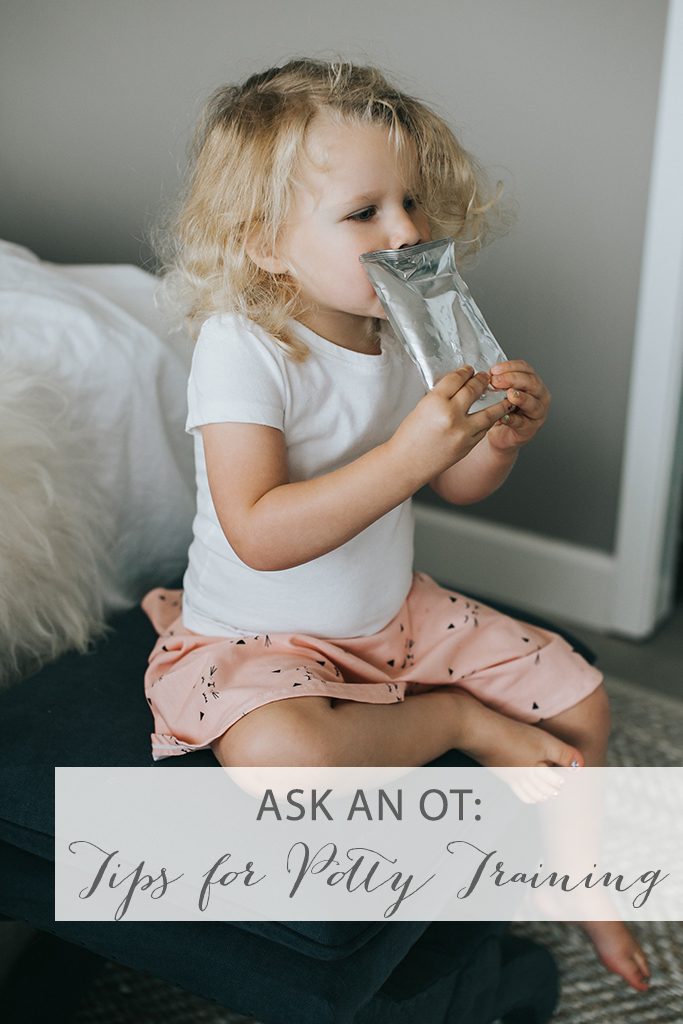
Recently after her bath, Waverley squated a tiny bit and peed all over the carpet. She neither knew it was coming nor acted affected by this display of urination, simply stating “I peed.” I ran down the hall to grab her little potty chair (which she sits on but does not actually potty in) yet it was too late, she was already done.
We are in the throes of potty training.
So when a reader emailed me asking for potty training tips for “Ask an OT,” I was thrilled! I am all about potty training right now and am happy to share an occupational therapist’s perspective for promoting success in this area of self-care. Are you also in the zone of potty training? Or have a babe who you hope will one day use the toilet? It’s such an important life skill to learn and has implications across numerous areas of life: social, self-care, self-efficacy, and independence, to name a few. Here are some important tips:
1. Know the signs. Kiddos begin to exhibit signs indicative of their readiness to toilet train between one to two years of age. We just need to be aware of them and able to identify the signs in order to start practicing the skill. Signs to look for include:
- Awareness of a wet or soiled diaper
- Interest in other people using the toilet
- Mimicking use of toilet paper for wiping
- Ability to follow two step demands
- Identification of urinating or about to start
2. Establish a routine. I know I sound like a broken record because everything always involves establishing a routine. Potty training is no exception! It’s important for kiddos to have consistency and know when to expect certain tasks. Having this predictability in one environment will lead to application of skills into other environments (i.e., where you are on the go). This also promotes the child’s ability to recognize signs in their body that they need to use the bathroom and then associate those signs with using the toilet. Within the daily routine of when and where, it is also helpful to have a routine for the order of tasks each time. You can establish a potty training routine by:
- Encourage potty use at the same time each day (wake-up, before nap, after nap, etc) and in regular intervals
- Have a picture board up by the potty with pictures of each step
- Sing a song involving the steps of toileting (we sing the song from Daniel Tiger: When you have to go potty stop and go right away. Flush and wash and be on your way!)
3. Make it easier. Before you can expect your child to use the bathroom by him or herself, they first must learn how to take off their clothes and diaper/underwear independently. Take time to teach these skills prior to potty training. To make this easier on everyone, promote their independence by dressing them in clothes that are toddler friendly, such as leggings or pants with elastic waistbands. Long dresses may be cute, too, but all of that material may actually hinder their ability to see what they are doing. Have easily accessible potty chairs on each floor or corner of the house to help prevent running to the bathroom accidents.
4. Stay positive and patient. Similar to sleeping and eating during infancy, potty training is a new life skill that your toddler is learning– and learning new skills takes time, patience, and encouragement. Do not punish your child for having accidents or not progressing at the speed in which you think they should. Teaching a child to use the toilet requires a set routine of boundaries yet necessitates a gentle touch through a positive attitude. Rather than berating a child for having an accident, simply tell them you understand learning to use the potty is hard work and accidents happen. If they’re old enough to conceptualize missed signs, try discussing those. Other than that, offer that the potty chair is always there whenever they need it.
5. Praise and reward. It is also important to have a routine and be consistent in this area too. It is recommended to have a special reward for going on the potty and it is only given for this purpose. It doesn’t have to be candy! It can be a special stickers, a small toy, or something else that is motivating to your little one depending on their personality. The key is to choose something that is not otherwise given and is reserved solely for going to the potty.
A few other tips:
- Keep your kiddo in diapers until they are consistently keeping their diaper dry in between pottying. Avoid switching to underwear too soon, which may lead to mutual frustration with a lot of early accidents!
- Follow your child’s lead. If your kiddo is completely uninterested in potty training, don’t push it. Wait a few months and reintroduce the topic again then.
- Do not compare your child to others! It’s not fair to them or to you.
- Sing songs or read a book while your kiddo sits on the potty. Usually toddlers can hardly sit still and actually using the potty may take time, so encourage them to stay on there by interacting with them.
- Here is a handy little printout written for the American Occupational Therapy Association with more information.
Do you have any other tried and true recommendations for potty training? I’d love to know, so please share them in the comments below!

Thank you!!
You are so welcome! I hope potty training is going well for you guys!